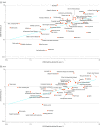Allocation of National Institutes of Health Funding by Disease Category in 2008 and 2019
- PMID: 33502486
- PMCID: PMC7841468
- DOI: 10.1001/jamanetworkopen.2020.34890
Allocation of National Institutes of Health Funding by Disease Category in 2008 and 2019
Abstract
Importance: Prior research suggests an association between burden of disease and National Institutes of Health (NIH) funding. The allocation of NIH funding should reflect, to some extent, the health needs of the population, along with other factors.
Objective: To examine the factors associated with NIH funding in 2019 for 46 diseases.
Design, setting, and participants: This cohort study used disability-adjusted life-years to measure the 2008 and 2019 US burden of disease and compared them with NIH categoric funding for 46 diseases.
Exposures: Disability-adjusted life-years to measure the 2008 and 2019 US burden of disease, 2016 health spending, and 2008 NIH funding levels for 46 diseases.
Main outcomes and measures: 2019 NIH funding levels for 46 diseases.
Results: The 46 diseases accounted for 62 392 713 of 94 399 784 disability-adjusted life-years (66.1%) in 2008 and 75 706 718 of 111 074 472 disability-adjusted life-years (68.2%) in 2019, representing more than 66% of all disability-adjusted life-years in both years. By dollar volume, Alzheimer and dementia increased the most, with approximately $1.8 billion more funding in 2019 than 2008 (from $530 million in 2008 to $2398 million in 2019, a 352% increase), whereas interpersonal violence had the greatest decrease, $95 million, in 2019 NIH funding (from $236 million in 2008 to $141 million in 2019, a 40% decrease). For the 46 diseases in this study, the variable with the greatest association with NIH funding in 2019 was the level of NIH funding in 2008, with a simple correlation of 0.88. Burden of disease and changes in burden of disease were not statistically significantly associated with NIH funding levels once the prior level of funding was included in the model. The models suggested that a 1% higher level of NIH funding in 2008 was associated with a 0.91% higher level of NIH funding in 2019.
Conclusions and relevance: In this study, NIH spending for most diseases seemed to be based primarily on the level of NIH spending more than 10 years earlier, despite changes in burden of disease. Congress and the NIH should examine the allocation process to ensure NIH investments are responsive to changes in the health of the population.
Conflict of interest statement
Figures


Similar articles
-
Comparing cutaneous research funded by the US National Institutes of Health (NIH) with the US skin disease burden.J Am Acad Dermatol. 2015 Sep;73(3):383-91.e1. doi: 10.1016/j.jaad.2015.04.039. Epub 2015 Jun 4. J Am Acad Dermatol. 2015. PMID: 26051697
-
The relation between funding by the National Institutes of Health and the burden of disease.N Engl J Med. 1999 Jun 17;340(24):1881-7. doi: 10.1056/NEJM199906173402406. N Engl J Med. 1999. PMID: 10369852
-
NIH disease funding levels and burden of disease.PLoS One. 2011 Feb 24;6(2):e16837. doi: 10.1371/journal.pone.0016837. PLoS One. 2011. PMID: 21383981 Free PMC article.
-
Geographic inequality in funding by National Institutes of Health negatively impacts almost one-half of the states in the United States.Front Public Health. 2024 Sep 25;12:1452494. doi: 10.3389/fpubh.2024.1452494. eCollection 2024. Front Public Health. 2024. PMID: 39386949 Free PMC article. Review.
-
Are we studying what matters? Health priorities and NIH-funded biomedical engineering research.Ann Biomed Eng. 2010 Jul;38(7):2237-51. doi: 10.1007/s10439-010-9982-9. Epub 2010 Mar 12. Ann Biomed Eng. 2010. PMID: 20225125 Review.
Cited by
-
NIH Funding of Violence Research by Institute, 2011 to 2020.JAMA. 2022 Jun 14;327(22):2240-2242. doi: 10.1001/jama.2022.5635. JAMA. 2022. PMID: 35699714 Free PMC article.
-
Gender as a social and structural variable: research perspectives from the National Institutes of Health (NIH).Transl Behav Med. 2024 Jan 11;14(1):13-22. doi: 10.1093/tbm/ibad014. Transl Behav Med. 2024. PMID: 37074158 Free PMC article.
-
Revising Conventional Wisdom About Histoplasmosis in the United States.Open Forum Infect Dis. 2021 Jun 10;8(7):ofab306. doi: 10.1093/ofid/ofab306. eCollection 2021 Jul. Open Forum Infect Dis. 2021. PMID: 34703835 Free PMC article. Review.
-
What are the Origins of Chronic Back Pain of "Obscure Origins"? Turning Toward Family and Workplace Social Contexts.Yale J Biol Med. 2022 Mar 31;95(1):153-163. eCollection 2022 Mar. Yale J Biol Med. 2022. PMID: 35370485 Free PMC article. Review.
-
Funding patterns for biomedical research and infectious diseases burden in Gabon.BMC Public Health. 2021 Nov 24;21(1):2155. doi: 10.1186/s12889-021-12201-w. BMC Public Health. 2021. PMID: 34819025 Free PMC article.
References
-
- National Institutes of Health. Mission and goals. Published October 31, 2014. Accessed July 6, 2020. https://www.nih.gov/about-nih/what-we-do/mission-goals
-
- Atkinson RD. Healthy Funding: The Critical Role of Investing in NIH to Boost Health and Lower Costs. Information Technology and Innovation Foundation; 2019. Accessed June 26, 2020. https://itif.org/publications/2019/03/25/healthy-funding-critical-role-i...
Publication types
MeSH terms
Grants and funding
LinkOut - more resources
Full Text Sources
Other Literature Sources

